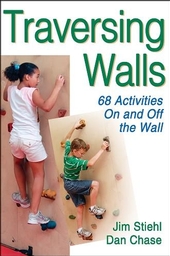MEDIA
REVIEW
This book defines what a student should know and be able to
do as result of a quality physical education program. The book
consists of two sections: section one focuses on "Exploring
the National Standards and Grade-Level Outcomes" while section
two address the challenge of "Implementing the Outcomes." Each
of the two sections is split into separate chapters. Section
one has 5 chapters and section two 4 chapters. The main
purpose of this book is to present the newly updated national
PE standards and then help teachers understand what these
standards might look like in terms of grade-level
expectations.
The book begins by presenting the new National Physical
Education Standards and the rationale for this new update. A
key change is the introduction of the term "physical literacy"
into each of the standards.
|
Title:
Traversing Walls
Publisher: Human Kinetics,
2008 Authors: J. Stiehl & D. Chase
Reviewer:
Laura Zavatto
ISBN: ISBN: 13:
9780736067775
Paperback: 160
pages
|
Additionally, there are now five standards replacing the
six previous standards. Chapter 1 begins by describing
and examining each of the standards. The chapter is brief and
straight to the point, which makes it easy to understand.
Chapter 2 presents the National Standards in a simple chart.
Summarized, the standards focus on the following: (1)
developing motor skills and movement competencies, (2)
applying knowledge of concepts, principles, strategies, and
tactics, (3) demonstrating the knowledge and skills needed to
maintain a healthy lifestyle (4) exhibiting responsible
personal and social behavior that respects self and others,
and (5) recognizing the value of physical activity for health,
enjoyment, challenge, self-expression, and/or social
interaction. Chapter 3 details sample elementary outcomes,
chapter 4 goes through the middle school outcomes, and chapter
5 describes the high school outcomes. Each chapter includes a
table of outcomes with two different levels.
Section two of the book begins by using charts to
illustrate the skills that should be achieved by each grade
level and at what level of competency. Three different
competency levels are identified: emerging, maturing, and
applying. Emerging is described as "Students participate in
deliberate practice tasks that will lead to skill and
knowledge acquisition." Maturing is described as "Students can
demonstrate the critical elements of the motor skills and
knowledge components of the grade-level outcomes, which will
continue to be refined with practice." And applying is
described as "Students can demonstrate the critical elements
of the motor skills and knowledge components of the
grade-level outcomes in a variety of physical activity
environments." Chapter 7 explains how to teach the content
that will help students successfully achieve the standards.
The last two chapters wrap up the book by summarizing how to
identify that students are learning together with outside
resources that physical educators can use to enhance their
instruction.
Overall, this newly updated national standards book is well
organized, has understandable charts that make it easier to
implement the standards, and has summaries after each chapter
that go over the most important parts. The book also includes
a glossary at the end that goes through the terminology that
is used through out the book. The book concludes with
information about becoming a SHAPE America member and how it
can benefit physical educators.If you are working with
beginner to intermediate climbers, this is a great kid-tested
resource with ideas and explanations that are quick and easy
to digest and use in a matter of minutes with plenty of room
to modify and alter to suit your students and equipment
needs. Proper terminology and useful vocabulary for
educators who are non-climbers are explained in the first
chapter.
Chapter 2 covers lead-up activities using no
climbing walls and simple dome cones. These activities
are great cooperative team challenges and can be used outside
of a climbing unit as well.
Chapter 3 takes common childhood games (e.g. Connect
the Dots, HORSE, Memory, Go-Fish and many more) and takes them
to the wall. These can be stimulating cognitive
challenges for your students.
Chapters 4 and 5 introduce interdisciplinary
concepts using math/numbers and words/letters. The games
are slanted towards academics but can easily be modified to
incorporate more physical literacy and math and made more
applicable for physical education. If you are into
helping out your classroom teachers by reinforcing what's
taught in class, you'll probably love these lessons just the
way they are.
Chapter 6 mainly focuses on activities that simulate
traveling to destinations and once again use an
interdisciplinary approach with social studies teaching and
reinforcing knowledge of States and Capitals.
And lastly, Chapter 7 reinforces science and health
concepts (overall wellness, nutrition, and the human body
including muscles, bones and body systems).
Fitness concepts (flexibility, upper and lower body
strength & endurance, & balance) as well as brain-body
connections with "depth of knowledge" vocabulary such as
sequencing, recalling, strategic thinking, recognizing,
cause/effect and so much more are very apparent throughout the
book making this a wonderful resource for thorough and highly
effective lesson planning. For those looking to hit all
those key buzz words for a lesson observation, your students
will be cognitively engaged using a constructivist learning
approach (do I hear APPR!?)! I liked this book
because it provides a novice or non-climber with a wealth of
basic climbing activities for a program that consists of low
level climbing. Safety is reviewed thoroughly as are
fundamental climbing techniques. I have a 9' x 12' wall
in my school, which even though it is small meets the needs of
my first through fifth graders fairly well. Many of the
games featured in the book can be used on a wall this size
though some activities would likely be better suited for
longer climbing walls. Overall, this is a great resource to
get started with ways to effectively utilize your climbing
wall and developing a climbing curriculum.
To Main MEDIA
Review Page
(back to pelinks4u
homepage) | 



